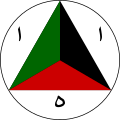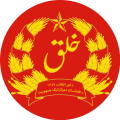|
Afghan Air Force (1978–1992)
The Afghan Air Force (Pashto: افغان هوايي ځواک, Persian: قوای هوایی افغانستان), officially known as the Afghan Air Force and Air Defense and sometimes referred to as the DRA Air Force or DRAAF,[1] was the aerial warfare branch of the Afghan Armed Forces from 1978 until the dissolution of the Democratic Republic of Afghanistan in April 1992. HistoryThe Afghan Air Force was redesignated the Royal Afghan Air Force in 1947, a title it retained until the 1973 Afghan coup d'état.[2][3] By 1960, the Royal Afghan Air Force consisted of approximately 100 combat aircraft including MiG-15 fighters, Il-28 light bombers, transports, and a few helicopters.[4] Also by that time, a small number of Afghan pilots were undergoing undergraduate pilot training in the United States, while others attended training in the Soviet Union, several European countries and India. In 1973 King Zahir Shah was deposed and Mohammed Daoud Khan became the country's president. During his five years in power, until the Saur Revolution of 1978, Daoud gained Soviet assistance to upgrade the capabilities and increase the size of the Afghan Air Force, introducing newer models of Soviet MiG-21 fighters and An-24 and An-26 transports. In 1979 the Air Force lost four Mi-8s.[5] Improvements in the early-to-mid-1970s notwithstanding, the Afghan Air Force remained relatively small until after the 1979–80 Soviet intervention in Afghanistan. The Afghan Air Force was at its strongest in the 1980s and early 1990s, producing some concern on the part of neighboring countries. The air force had around 20,000 personnel plus 5,000 foreign advisors in 1986. At its peak, the Afghan Air Force had at least 240 fixed-wing fighters, fighter-bombers and light bombers. The Afghan Air Force probably operated some 40 or more transports, including the Antonov An-26, Antonov An-24, and Antonov An-2.[6] Two estimates, one from Mark Urban and one from the CIA, paint a more detailed picture of the Afghan Air Force:[7][1]
The Mil Mi-24 and Mi-35 (export model) attack helicopters have a long history in Afghanistan. The aircraft was operated extensively during the Soviet-Afghan War, mainly for attacking mujahideen fighters. Early in the war, the only anti-air weapons of the mujahideen were Soviet-made, shoulder-launched, heat-seeking SAMs and American Redeye, which had either been captured from the Soviets or their Afghan allies or were supplied by Western sources. Many of them came from stocks the Israelis had captured during their wars with Soviet client states in the Middle East. Owing to a combination of the limited capabilities of these early types of missiles, poor training and poor material condition of the missiles, they were not particularly effective.[8] Beginning in 1986, the US supplied the mujahideen with its state-of-the-art heat-seeking missile, the FIM-92 Stinger, which the Afghans employed with devastating effect. In the first use of the Stinger in Afghanistan, mujahideen fighters downed three of eight unsuspecting Soviet Mi-24 Hinds as they approached the airfield at Jalalabad on a late September afternoon. Some scholars point to that event in 1986 as the turning point in the war. Moreover, for most of the remainder of the war when Stingers were known to be present, Soviet and Afghan aircraft elected to remain at higher altitudes where they were less vulnerable to the missile, but also less effective in ground attacks. Although employed extensively throughout the war as a ground attack platform, the Hind suffered from a weak tail boom and was found to be underpowered for some missions it was called upon to perform in the mountains of Afghanistan, where high density altitude is especially problematic for rotary-wing aircraft.[9][10] Overall, the Hind proved effective and very reliable, earning the respect of both Soviet and Afghan pilots as well as ordinary Afghans throughout the country. The mujahideen nicknamed the Mi-24 the "Devil's Chariot" due to its notorious reputation.[9] After the Soviet withdrawal and the departure of foreign advisors, the Air Force declined in terms of operational capability. With the collapse of the Najibullah Government in 1992, the Air Force splintered, breaking up amongst the different mujahideen factions in the ongoing civil war. By the end of the 1990s, the Taliban maintained five supersonic MiG-21MF and 10 Sukhoi Su-22 fighter-bombers.[11] They also held six Mil Mi-8 helicopters, five Mi-35s, five L-39Cs, six An-12s, 25 An-26s, a dozen An-24/32s, an IL-18, and a Yakovlev.[12] The Afghan Northern Alliance/United Front operated a small number of helicopters and transports and a few other aircraft for which it depended on assistance from neighboring Tajikistan. With the breakdown of logistical systems, the cannibalization of surviving airframes was widespread. The US air campaign in the fall of 2001 destroyed most of the remaining Afghan aircraft. Aircraft and PersonnelOn February 1, 1986, the staffing of military equipment and personnel of the Air Force and Air Defense was:[13]
Midway through the Soviet–Afghan War, one estimate listed the following inventory:
LossesFrom the Saur Revolution until the dissolution of the Republic of Afghanistan in April of 1992, the Afghan Air Force lost 617 aircraft and 651 crew members. Many of which were shot down by American Stinger missiles provided to the Mujahideen through Operation Cyclone.[20] InsigniaDuring its first incarnation, Afghan aircraft carried simple black and white depictions of the Arms of Afghanistan, with the inscription 'God is great' on the underside of the wings. The Afghan flag was possibly used as well. Afghanistan adopted a black, red, and green flag after the 1929 revolt, and when the Air Force was given aircraft again in 1937, it placed this flag on the rudder, and adopted wing and fuselage roundels based on the three colors.
The Royal Afghan Air Force retained the roundels until adopting a new style in 1967, with a unique insignia consisting of a tri-color triangle using the national colors upon a white disc, on which was inscribed with Pashto lettering forming various phrases. This roundel was placed on the rudder in place of the flag. This remained in use after the overthrow of the monarchy until the Saur Revolution in 1978, when a new insignia of a red disc with yellow inscriptions was adopted. This was short-lived however, as in 1983, an emblem more reminiscent of the 1937 Afghan Airforce roundel was adopted which featured a red star on a white disc ringed in black, red, and green was adopted.[21] These were in use until the fall of the Najibullah regime in April 1992.[22] See also
References
|
||||||||||||||||||||||
Portal di Ensiklopedia Dunia



